Evidence-Based Practice Proposal: Harris Health System, Asthma Care
VerifiedAdded on 2020/05/11
|6
|1380
|85
Report
AI Summary
This report presents an evidence-based practice proposal focusing on the management of paediatric asthma within the Harris Health System. The proposal addresses the growing concern of asthma in children, characterized by recurring symptoms and bronchiospasms, which leads to frequent clinic visits, school absences, and other complications. The project aims to implement school-based interventions to empower nurses with evidence-based strategies, reduce clinic visits by over 10% within six months, and improve patient outcomes. The PICOT question investigates whether effective school-based interventions can decrease frequent clinic visits. The report highlights the role of nurses as key stakeholders and the need for improved education and communication. It outlines specific objectives aligned with the SMART framework, focusing on improving care delivery, reducing poor outcomes, and enhancing management strategies. The project's rationale emphasizes the challenges nurses face in educating patients and the potential of school-based interventions to address these challenges. The report includes an initial reference list of relevant literature supporting the proposed interventions and the need for evidence-based practice in paediatric asthma management.
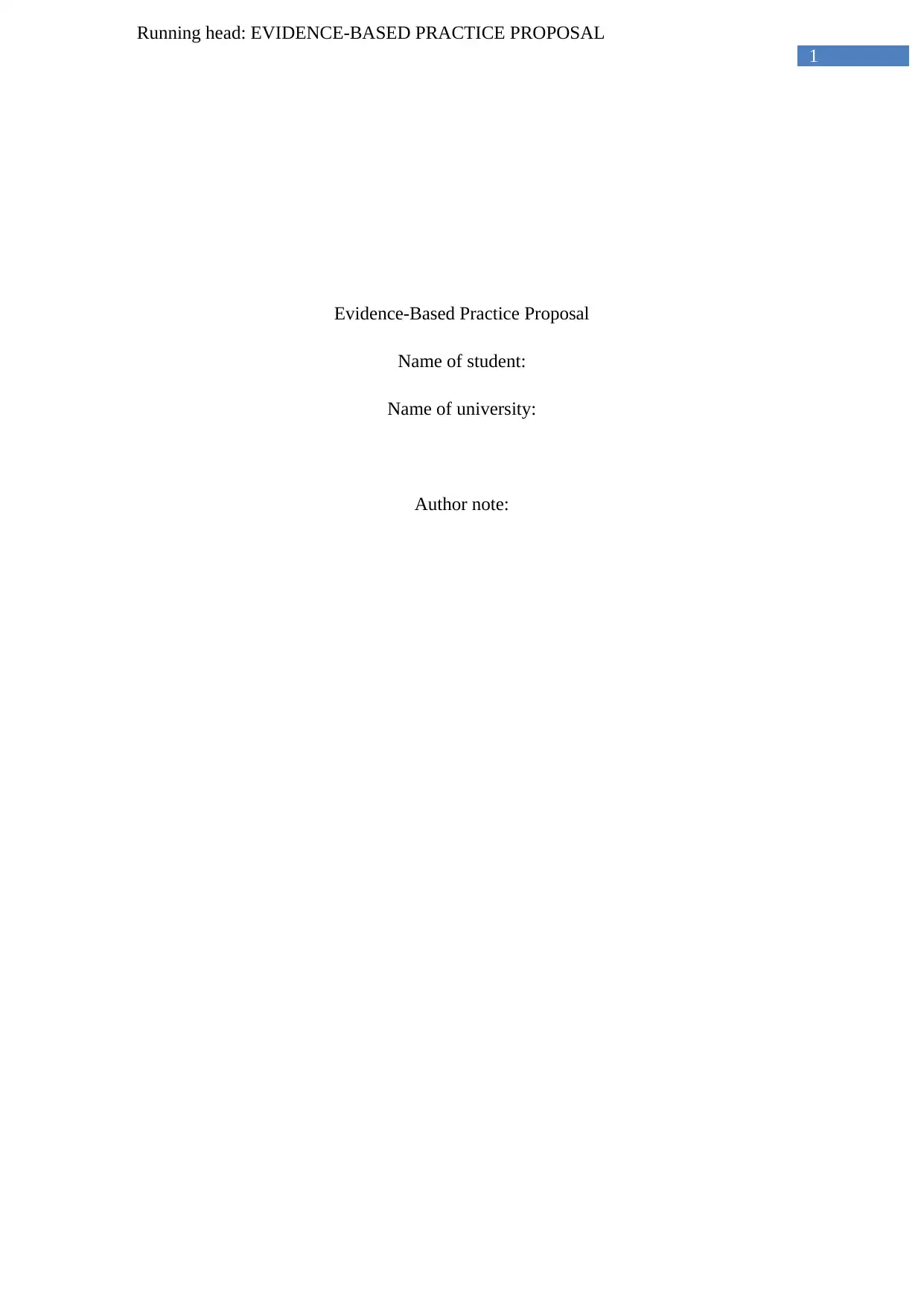
1
Running head: EVIDENCE-BASED PRACTICE PROPOSAL
Evidence-Based Practice Proposal
Name of student:
Name of university:
Author note:
Running head: EVIDENCE-BASED PRACTICE PROPOSAL
Evidence-Based Practice Proposal
Name of student:
Name of university:
Author note:
Paraphrase This Document
Need a fresh take? Get an instant paraphrase of this document with our AI Paraphraser
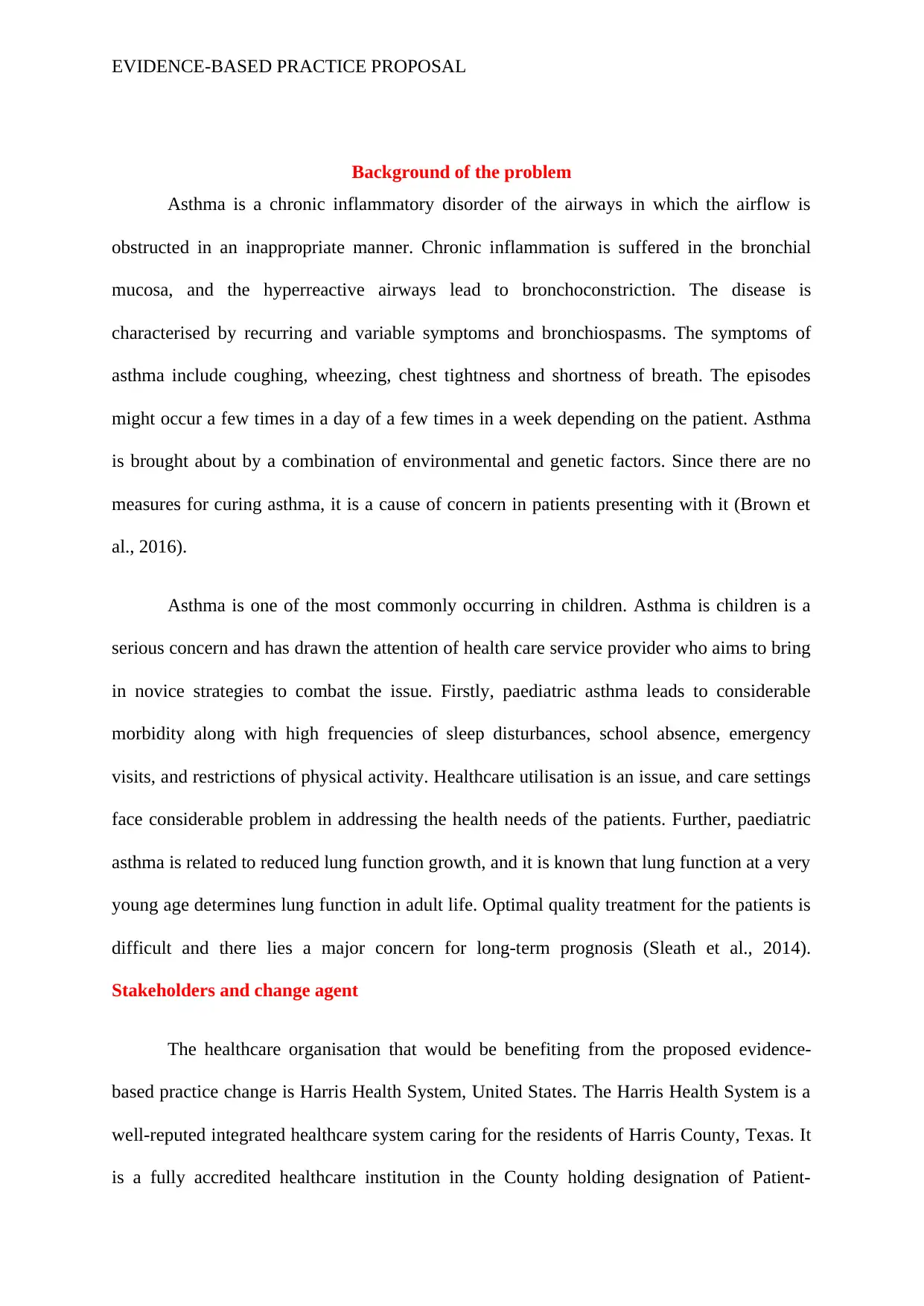
EVIDENCE-BASED PRACTICE PROPOSAL
Background of the problem
Asthma is a chronic inflammatory disorder of the airways in which the airflow is
obstructed in an inappropriate manner. Chronic inflammation is suffered in the bronchial
mucosa, and the hyperreactive airways lead to bronchoconstriction. The disease is
characterised by recurring and variable symptoms and bronchiospasms. The symptoms of
asthma include coughing, wheezing, chest tightness and shortness of breath. The episodes
might occur a few times in a day of a few times in a week depending on the patient. Asthma
is brought about by a combination of environmental and genetic factors. Since there are no
measures for curing asthma, it is a cause of concern in patients presenting with it (Brown et
al., 2016).
Asthma is one of the most commonly occurring in children. Asthma is children is a
serious concern and has drawn the attention of health care service provider who aims to bring
in novice strategies to combat the issue. Firstly, paediatric asthma leads to considerable
morbidity along with high frequencies of sleep disturbances, school absence, emergency
visits, and restrictions of physical activity. Healthcare utilisation is an issue, and care settings
face considerable problem in addressing the health needs of the patients. Further, paediatric
asthma is related to reduced lung function growth, and it is known that lung function at a very
young age determines lung function in adult life. Optimal quality treatment for the patients is
difficult and there lies a major concern for long-term prognosis (Sleath et al., 2014).
Stakeholders and change agent
The healthcare organisation that would be benefiting from the proposed evidence-
based practice change is Harris Health System, United States. The Harris Health System is a
well-reputed integrated healthcare system caring for the residents of Harris County, Texas. It
is a fully accredited healthcare institution in the County holding designation of Patient-
Background of the problem
Asthma is a chronic inflammatory disorder of the airways in which the airflow is
obstructed in an inappropriate manner. Chronic inflammation is suffered in the bronchial
mucosa, and the hyperreactive airways lead to bronchoconstriction. The disease is
characterised by recurring and variable symptoms and bronchiospasms. The symptoms of
asthma include coughing, wheezing, chest tightness and shortness of breath. The episodes
might occur a few times in a day of a few times in a week depending on the patient. Asthma
is brought about by a combination of environmental and genetic factors. Since there are no
measures for curing asthma, it is a cause of concern in patients presenting with it (Brown et
al., 2016).
Asthma is one of the most commonly occurring in children. Asthma is children is a
serious concern and has drawn the attention of health care service provider who aims to bring
in novice strategies to combat the issue. Firstly, paediatric asthma leads to considerable
morbidity along with high frequencies of sleep disturbances, school absence, emergency
visits, and restrictions of physical activity. Healthcare utilisation is an issue, and care settings
face considerable problem in addressing the health needs of the patients. Further, paediatric
asthma is related to reduced lung function growth, and it is known that lung function at a very
young age determines lung function in adult life. Optimal quality treatment for the patients is
difficult and there lies a major concern for long-term prognosis (Sleath et al., 2014).
Stakeholders and change agent
The healthcare organisation that would be benefiting from the proposed evidence-
based practice change is Harris Health System, United States. The Harris Health System is a
well-reputed integrated healthcare system caring for the residents of Harris County, Texas. It
is a fully accredited healthcare institution in the County holding designation of Patient-
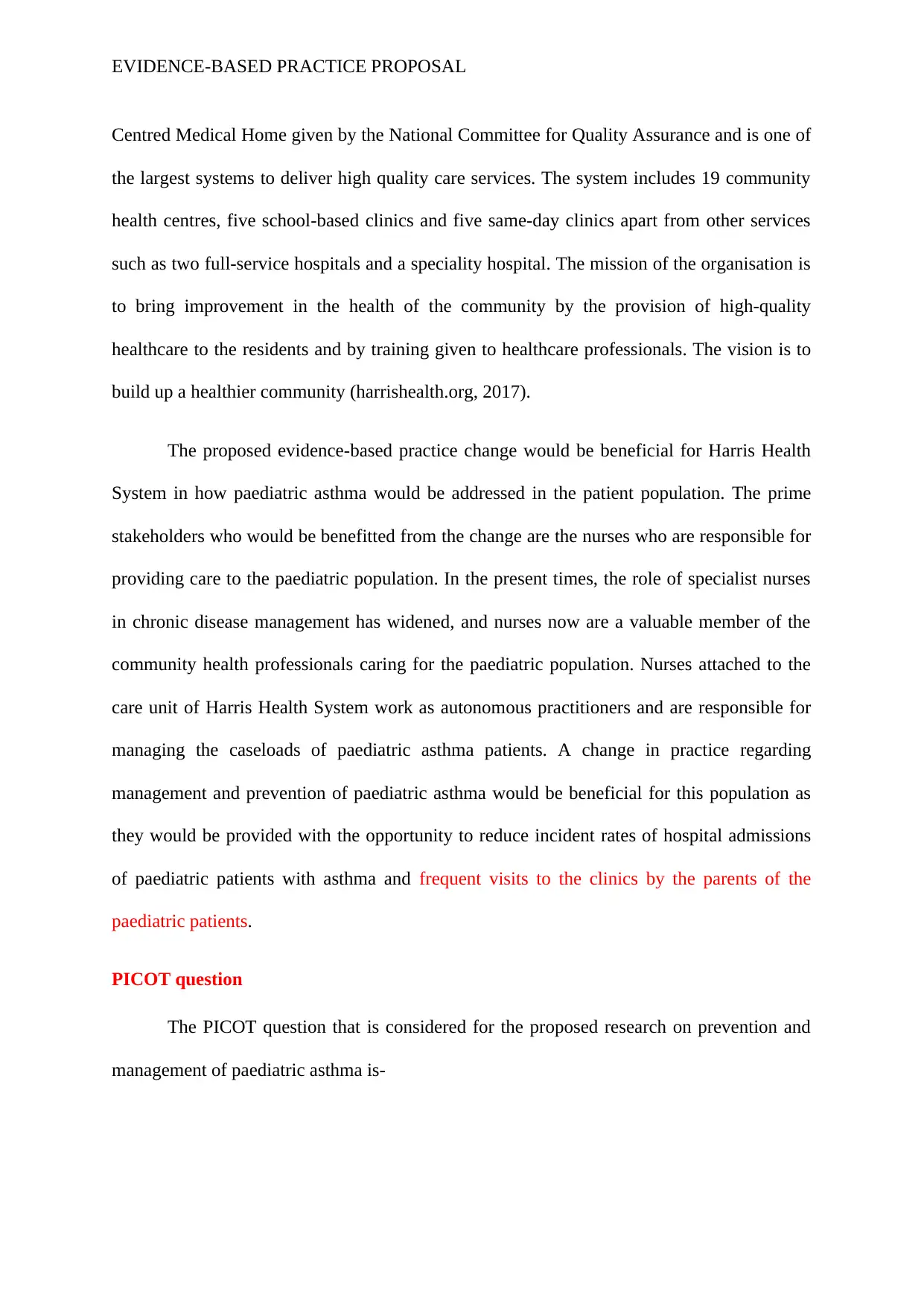
EVIDENCE-BASED PRACTICE PROPOSAL
Centred Medical Home given by the National Committee for Quality Assurance and is one of
the largest systems to deliver high quality care services. The system includes 19 community
health centres, five school-based clinics and five same-day clinics apart from other services
such as two full-service hospitals and a speciality hospital. The mission of the organisation is
to bring improvement in the health of the community by the provision of high-quality
healthcare to the residents and by training given to healthcare professionals. The vision is to
build up a healthier community (harrishealth.org, 2017).
The proposed evidence-based practice change would be beneficial for Harris Health
System in how paediatric asthma would be addressed in the patient population. The prime
stakeholders who would be benefitted from the change are the nurses who are responsible for
providing care to the paediatric population. In the present times, the role of specialist nurses
in chronic disease management has widened, and nurses now are a valuable member of the
community health professionals caring for the paediatric population. Nurses attached to the
care unit of Harris Health System work as autonomous practitioners and are responsible for
managing the caseloads of paediatric asthma patients. A change in practice regarding
management and prevention of paediatric asthma would be beneficial for this population as
they would be provided with the opportunity to reduce incident rates of hospital admissions
of paediatric patients with asthma and frequent visits to the clinics by the parents of the
paediatric patients.
PICOT question
The PICOT question that is considered for the proposed research on prevention and
management of paediatric asthma is-
Centred Medical Home given by the National Committee for Quality Assurance and is one of
the largest systems to deliver high quality care services. The system includes 19 community
health centres, five school-based clinics and five same-day clinics apart from other services
such as two full-service hospitals and a speciality hospital. The mission of the organisation is
to bring improvement in the health of the community by the provision of high-quality
healthcare to the residents and by training given to healthcare professionals. The vision is to
build up a healthier community (harrishealth.org, 2017).
The proposed evidence-based practice change would be beneficial for Harris Health
System in how paediatric asthma would be addressed in the patient population. The prime
stakeholders who would be benefitted from the change are the nurses who are responsible for
providing care to the paediatric population. In the present times, the role of specialist nurses
in chronic disease management has widened, and nurses now are a valuable member of the
community health professionals caring for the paediatric population. Nurses attached to the
care unit of Harris Health System work as autonomous practitioners and are responsible for
managing the caseloads of paediatric asthma patients. A change in practice regarding
management and prevention of paediatric asthma would be beneficial for this population as
they would be provided with the opportunity to reduce incident rates of hospital admissions
of paediatric patients with asthma and frequent visits to the clinics by the parents of the
paediatric patients.
PICOT question
The PICOT question that is considered for the proposed research on prevention and
management of paediatric asthma is-
⊘ This is a preview!⊘
Do you want full access?
Subscribe today to unlock all pages.

Trusted by 1+ million students worldwide
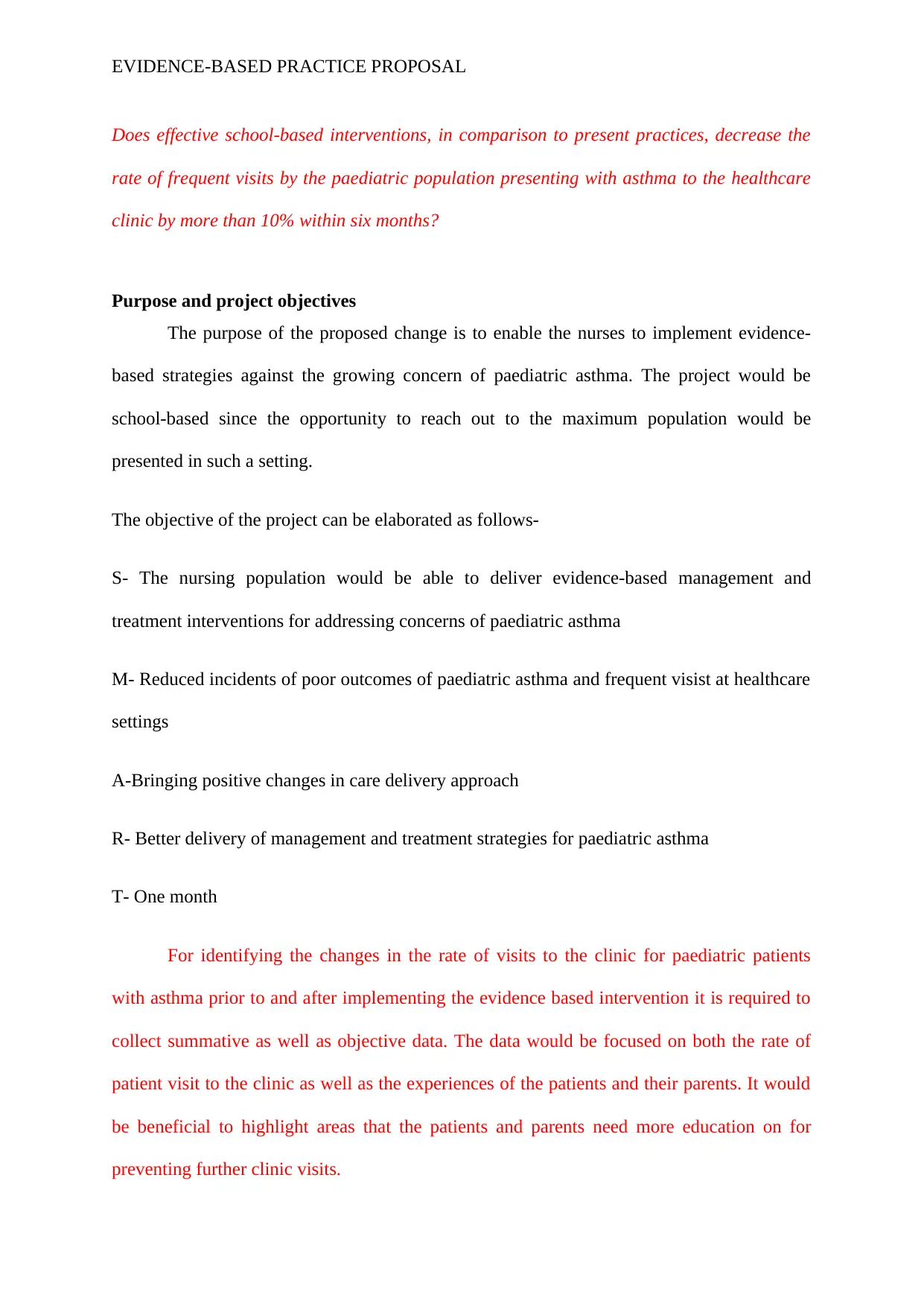
EVIDENCE-BASED PRACTICE PROPOSAL
Does effective school-based interventions, in comparison to present practices, decrease the
rate of frequent visits by the paediatric population presenting with asthma to the healthcare
clinic by more than 10% within six months?
Purpose and project objectives
The purpose of the proposed change is to enable the nurses to implement evidence-
based strategies against the growing concern of paediatric asthma. The project would be
school-based since the opportunity to reach out to the maximum population would be
presented in such a setting.
The objective of the project can be elaborated as follows-
S- The nursing population would be able to deliver evidence-based management and
treatment interventions for addressing concerns of paediatric asthma
M- Reduced incidents of poor outcomes of paediatric asthma and frequent visist at healthcare
settings
A-Bringing positive changes in care delivery approach
R- Better delivery of management and treatment strategies for paediatric asthma
T- One month
For identifying the changes in the rate of visits to the clinic for paediatric patients
with asthma prior to and after implementing the evidence based intervention it is required to
collect summative as well as objective data. The data would be focused on both the rate of
patient visit to the clinic as well as the experiences of the patients and their parents. It would
be beneficial to highlight areas that the patients and parents need more education on for
preventing further clinic visits.
Does effective school-based interventions, in comparison to present practices, decrease the
rate of frequent visits by the paediatric population presenting with asthma to the healthcare
clinic by more than 10% within six months?
Purpose and project objectives
The purpose of the proposed change is to enable the nurses to implement evidence-
based strategies against the growing concern of paediatric asthma. The project would be
school-based since the opportunity to reach out to the maximum population would be
presented in such a setting.
The objective of the project can be elaborated as follows-
S- The nursing population would be able to deliver evidence-based management and
treatment interventions for addressing concerns of paediatric asthma
M- Reduced incidents of poor outcomes of paediatric asthma and frequent visist at healthcare
settings
A-Bringing positive changes in care delivery approach
R- Better delivery of management and treatment strategies for paediatric asthma
T- One month
For identifying the changes in the rate of visits to the clinic for paediatric patients
with asthma prior to and after implementing the evidence based intervention it is required to
collect summative as well as objective data. The data would be focused on both the rate of
patient visit to the clinic as well as the experiences of the patients and their parents. It would
be beneficial to highlight areas that the patients and parents need more education on for
preventing further clinic visits.
Paraphrase This Document
Need a fresh take? Get an instant paraphrase of this document with our AI Paraphraser
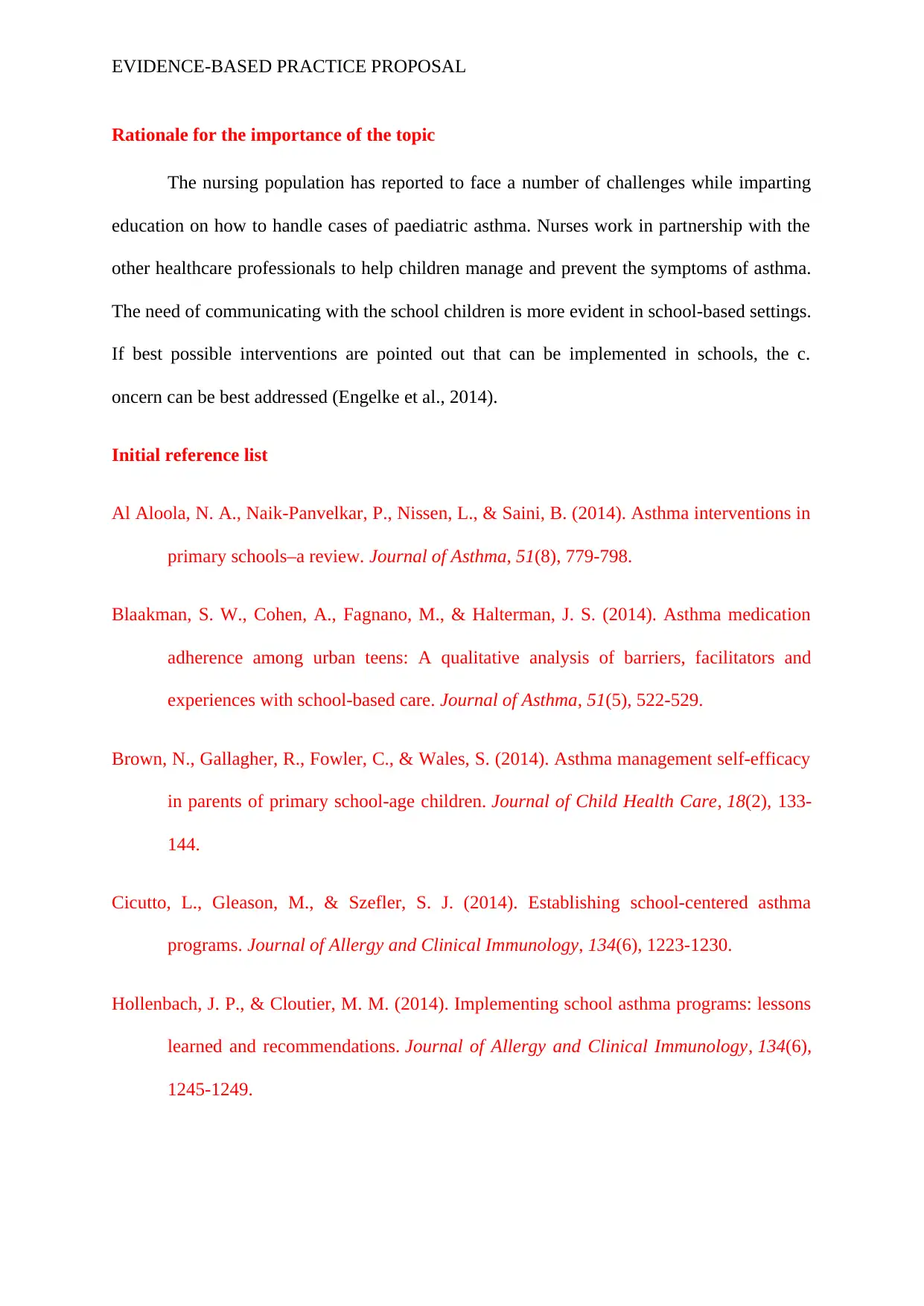
EVIDENCE-BASED PRACTICE PROPOSAL
Rationale for the importance of the topic
The nursing population has reported to face a number of challenges while imparting
education on how to handle cases of paediatric asthma. Nurses work in partnership with the
other healthcare professionals to help children manage and prevent the symptoms of asthma.
The need of communicating with the school children is more evident in school-based settings.
If best possible interventions are pointed out that can be implemented in schools, the c.
oncern can be best addressed (Engelke et al., 2014).
Initial reference list
Al Aloola, N. A., Naik-Panvelkar, P., Nissen, L., & Saini, B. (2014). Asthma interventions in
primary schools–a review. Journal of Asthma, 51(8), 779-798.
Blaakman, S. W., Cohen, A., Fagnano, M., & Halterman, J. S. (2014). Asthma medication
adherence among urban teens: A qualitative analysis of barriers, facilitators and
experiences with school-based care. Journal of Asthma, 51(5), 522-529.
Brown, N., Gallagher, R., Fowler, C., & Wales, S. (2014). Asthma management self-efficacy
in parents of primary school-age children. Journal of Child Health Care, 18(2), 133-
144.
Cicutto, L., Gleason, M., & Szefler, S. J. (2014). Establishing school-centered asthma
programs. Journal of Allergy and Clinical Immunology, 134(6), 1223-1230.
Hollenbach, J. P., & Cloutier, M. M. (2014). Implementing school asthma programs: lessons
learned and recommendations. Journal of Allergy and Clinical Immunology, 134(6),
1245-1249.
Rationale for the importance of the topic
The nursing population has reported to face a number of challenges while imparting
education on how to handle cases of paediatric asthma. Nurses work in partnership with the
other healthcare professionals to help children manage and prevent the symptoms of asthma.
The need of communicating with the school children is more evident in school-based settings.
If best possible interventions are pointed out that can be implemented in schools, the c.
oncern can be best addressed (Engelke et al., 2014).
Initial reference list
Al Aloola, N. A., Naik-Panvelkar, P., Nissen, L., & Saini, B. (2014). Asthma interventions in
primary schools–a review. Journal of Asthma, 51(8), 779-798.
Blaakman, S. W., Cohen, A., Fagnano, M., & Halterman, J. S. (2014). Asthma medication
adherence among urban teens: A qualitative analysis of barriers, facilitators and
experiences with school-based care. Journal of Asthma, 51(5), 522-529.
Brown, N., Gallagher, R., Fowler, C., & Wales, S. (2014). Asthma management self-efficacy
in parents of primary school-age children. Journal of Child Health Care, 18(2), 133-
144.
Cicutto, L., Gleason, M., & Szefler, S. J. (2014). Establishing school-centered asthma
programs. Journal of Allergy and Clinical Immunology, 134(6), 1223-1230.
Hollenbach, J. P., & Cloutier, M. M. (2014). Implementing school asthma programs: lessons
learned and recommendations. Journal of Allergy and Clinical Immunology, 134(6),
1245-1249.
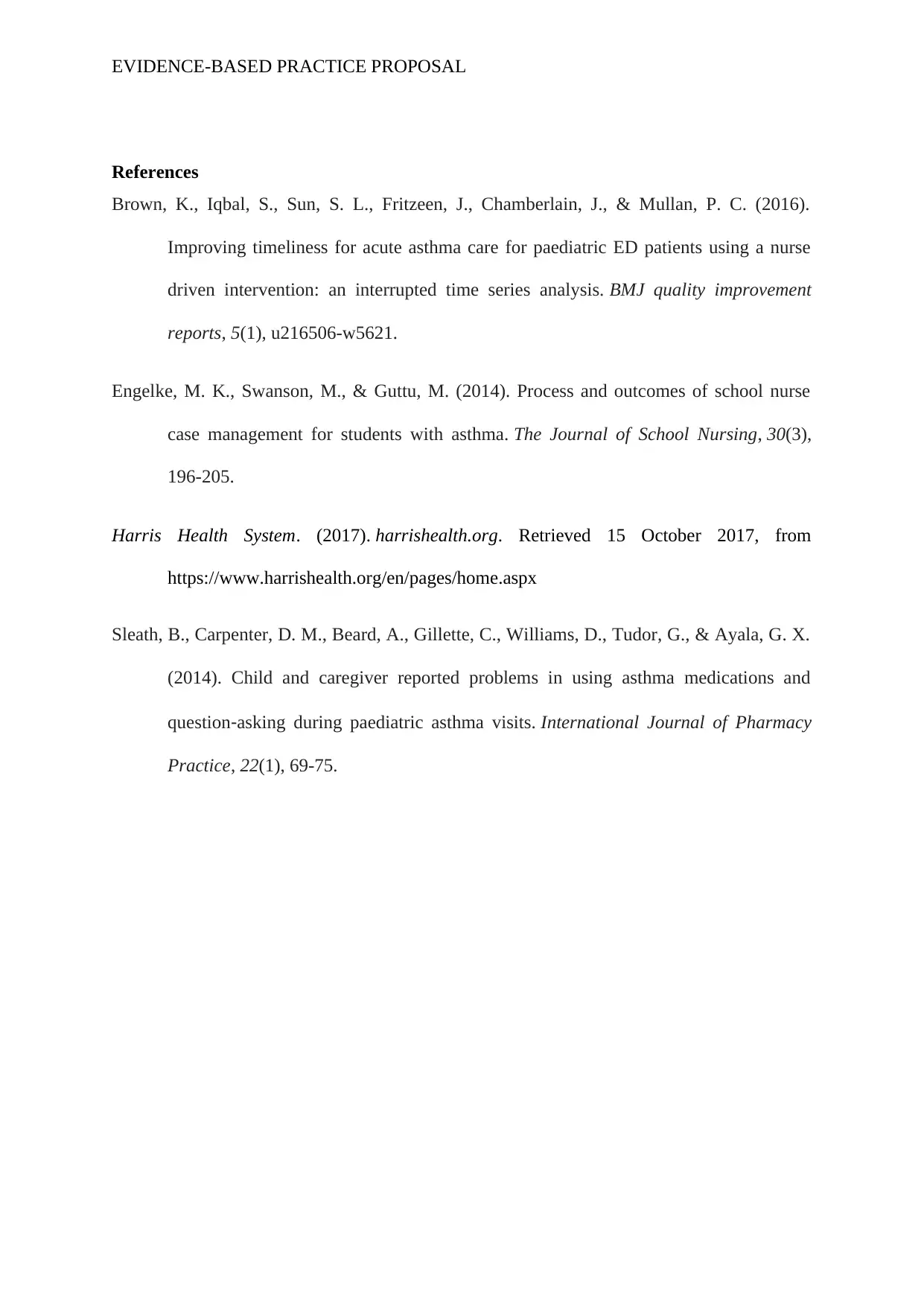
EVIDENCE-BASED PRACTICE PROPOSAL
References
Brown, K., Iqbal, S., Sun, S. L., Fritzeen, J., Chamberlain, J., & Mullan, P. C. (2016).
Improving timeliness for acute asthma care for paediatric ED patients using a nurse
driven intervention: an interrupted time series analysis. BMJ quality improvement
reports, 5(1), u216506-w5621.
Engelke, M. K., Swanson, M., & Guttu, M. (2014). Process and outcomes of school nurse
case management for students with asthma. The Journal of School Nursing, 30(3),
196-205.
Harris Health System. (2017). harrishealth.org. Retrieved 15 October 2017, from
https://www.harrishealth.org/en/pages/home.aspx
Sleath, B., Carpenter, D. M., Beard, A., Gillette, C., Williams, D., Tudor, G., & Ayala, G. X.
(2014). Child and caregiver reported problems in using asthma medications and
question‐asking during paediatric asthma visits. International Journal of Pharmacy
Practice, 22(1), 69-75.
References
Brown, K., Iqbal, S., Sun, S. L., Fritzeen, J., Chamberlain, J., & Mullan, P. C. (2016).
Improving timeliness for acute asthma care for paediatric ED patients using a nurse
driven intervention: an interrupted time series analysis. BMJ quality improvement
reports, 5(1), u216506-w5621.
Engelke, M. K., Swanson, M., & Guttu, M. (2014). Process and outcomes of school nurse
case management for students with asthma. The Journal of School Nursing, 30(3),
196-205.
Harris Health System. (2017). harrishealth.org. Retrieved 15 October 2017, from
https://www.harrishealth.org/en/pages/home.aspx
Sleath, B., Carpenter, D. M., Beard, A., Gillette, C., Williams, D., Tudor, G., & Ayala, G. X.
(2014). Child and caregiver reported problems in using asthma medications and
question‐asking during paediatric asthma visits. International Journal of Pharmacy
Practice, 22(1), 69-75.
⊘ This is a preview!⊘
Do you want full access?
Subscribe today to unlock all pages.

Trusted by 1+ million students worldwide
1 out of 6
Related Documents
Your All-in-One AI-Powered Toolkit for Academic Success.
+13062052269
info@desklib.com
Available 24*7 on WhatsApp / Email
![[object Object]](/_next/static/media/star-bottom.7253800d.svg)
Unlock your academic potential
Copyright © 2020–2025 A2Z Services. All Rights Reserved. Developed and managed by ZUCOL.





